Professor Jin Wang, Director of Liverpool Logistics, Offshore and Marine (LOOM) Research Institute at Liverpool John Moores University will deliver the next FSI invited seminar on “Challenges and Developments in Maritime Safety and Security Assessment” this thursday 26/05/2016 in Boldrewood Innovation Campus B176 Seminar Room 2013, 12:00-13:00
You are warmly welcomed to join us.
Abstract
Safety and security assessment has been increasingly used to support maritime system design and operation. There has also been a growing international recognition that security issues of maritime systems need to be reviewed. This presentation will address major challenges and developments in maritime safety and security assessment. In particular, areas covered include regulatory regimes in maritime safety and security, IMO’s formal safety assessment, sea port security modelling, and piracy related ship operations together with case studies. Some advanced techniques for maritime safety and security assessment are outlined to demonstrate their potential application.
Biography
Jin Wang is Professor of Marine Technology and Director of Liverpool Logistics, Offshore and Marine (LOOM) Research Institute at Liverpool John Moores University (LJMU), UK. Following just less than 5 years’ research as a research associate at Newcastle University, he joined LJMU as a lecturer in 1995, and was promoted as Reader in Marine Engineering and Professor of Marine Technology in 1999 and 2002 respectively. He has been involved in maritime safety and security for the past 25 years. His extensive publications include 2 research monographs and more than 100 SCI cited journal papers relating to maritime safety and security. He has completed supervision of more than 40 doctoral/postdoctoral researchers in the fields of maritime safety and security.
Hydro team is gearing up for this summer's contest
Preparations are well underway in Southampton by the student team looking to compete in HYDROcontest 2016. This competition brings together engineers and naval architects from all over Europe and beyond to face technical and management challenges.
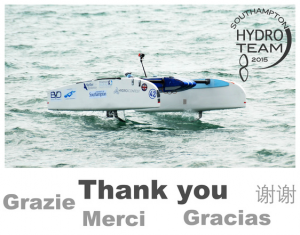
The University of Southampton team took part for the first time last summer. One of the company partners ABB was looking for a student to take up an industrial challenge of optimising the hydrodynamics of an electrical pod (thrust unit) for a six month internship at Hydros Innovation in Lausanne.

One of our MS students, Nicolas Verkant member of the 2015 Southampton Hydro Team applied as he was looking for a complex and interesting project to begin my career with. It was great news that he was selected and took up the challenge starting in mid February. Nicolas reports, ‘ I spent a few days discovering the goals, constraints, software and geometries. I ran a few simulations in order to find the correct setups before starting the optimisation process. The project really is interesting as a R&D study and also because it is a concrete case that may improve maritime transportation efficiency. The great quality work of the 2015 Southampton Hydro Team has been determinant for my application for this project. Therefore I really encourage people to take part in such a great adventure as this will develop knowledge and skills in very diverse fields, and it may even bring career opportunities. Good luck!’
Ariadna Pons Forn, MSc Yacht & Small Craft 15/16 and Marion James, PhD research student in the Fluid Structure Interactions group, went to the RINA headquarters in London on the 24th of February 2016 to attend the Maritime Project Management conference. They thank ABS and BMT for supporting them with sponsored student places.

Several speakers discussed the challenges related to the management of concept design projects. In addition, the increased complexity of working in a multi-cultural ship building project was raised. Ariadna and Marion learnt key points to ensure good communication in the multi-cultural and multi-discipline project that is the Southampton Hydro Team.
www.SouthamptonHydroTeam.co.uk
Science of Ships

Ship science are participating in this year’s University Science and Engineering week activities on Saturday 12th March on our Boldrewood Innovation Campus. All are welcome – see University website for more information.
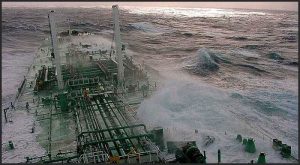
This is a great opportunity to meet staff and students and learn about some of the technical challenges involved in designing ships and offshore structures. A series of hands-on activities and demonstrations of the wave crawler ‘Fleur’ in the towing tank will be available for all ages to explore.
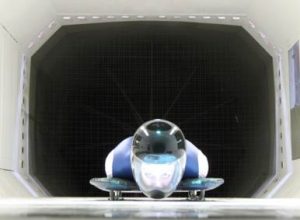
Prof Turnock will be giving a talk ‘Headfirst to success’ in the LR Auditorium at 11:25 and 14:45. In this he will explore some of the science and engineering behind performance in the wintersport of skeleton and also the links into Ship Design.
Whipping and Springing of Ships
Prof Nigel White will be giving the FSI seminar on Thursday 10th march, 12;00-13:00 in B176L room 1125. All are welcome.
Typically, Lloyd’s Rules for the design and construction of ships develop on a largely evolutionary process, however there are often very rapid advances in ship size or design which mean that the evolution process is questionable. The rules and design procedures are also updated on the basis of improved design technology. There has been a huge growth in the size of container ships, in 2000 the biggest ships were 8000 TEU with a length of 300m and beam of 43m, today the ultra large container ships (ULCS) 21,000 TEU have a length of 400m and beam of 60m. This growth is testing the existing evolutionary process, however current computer power means that we can develop procedures that allow us to assess the very complex effects of whipping and springing on the structure of these ULCS.
Containerships are unique in that they have very large deck openings, long hull forms, large bow flare and operate at fairly high operational speeds (roughly 18 knots or over). Each of these pose challenges on their own, but when combined the effect is potentially even more severe. The large deck openings mean that the torsional rigidity of the vessel is low and very high strength and thick steel is required for the deck and hatch coamings, the bow flare and high speed mean that the impact loads due to waves are high (whipping), the long length means that the natural vibration frequency of the hull girder is low and close to the encounter wave period due to the high speed (springing). LR has been working on the assessment of these issues over recent years and has taken the work developed by the universities back in the early 90s (including Southampton) into practical procedures that can be consistently applied.
The presentation gives an oversight into some of the issues related to the assessment of whipping and springing for ULCS. The need for such procedures was highlighted by the recent container ship total losses where whipping was a contributory factor.
Biography
Nigel is a Senior Principal Hydrodynamicist at Lloyds Register and works in the Structural Analysis and Hydrodynamics research group. He has also been recently elected as a Visiting Professor at the University of Southampton in the Ship Science department. Nigel has been with LR for 23 years and is the lead engineer for the development of Lloyds Register’s procedures in areas related to hydrodynamic expertise including ship motions, hydroelasticity (whipping/springing responses), impact loads, sloshing loads, dynamic load application, fluid structure interactions, etc. for all ship types. He has also been involved in many of the IACS working groups involving loads on ships.
Optimal trim control of high speed craft
Our FSI seminar series continues with Dr Melek Ertogan from Istanbul Technical University on Thursday 3rd March from 12:00-13:00
Optimal trim control of high speed crafts in calm sea is being studied in the most recent project. The purpose of the automatic trim control is to improve fuel efficiency, safety and comfort of passengers in a vessel. Trim tabs, interceptors, and sterndrive engines can be used to control the trim of a high speed craft.
The trim tabs and the interceptors were mounted on a craft Volcano71, in length 10.86m, for the real-time applications. The sterndrive engines of a Volcano71 have 2×380 HP and it reaches maximum of 40 knots. The pulse width modulation (PWM) drivers were provided for the interceptor, the trim tabs and the sterndrive systems of the gasoline engines can be manually trimmed. By the end of this project, they will be automatically trimmed by employing the mechatronic setup and an algorithm.
The energy saving systems were operated manually in calm sea for system identification purposes and observing maximum effects. After finalizing the simulation studies of the optimal trim control on the system identification model, the investigations of full scale trials will be realized. Performance of the automatic trim control for a high speed craft can be evaluated with a GPS-aided inertial measurement unit (IMU) at the same motor power while a trim tab, an interceptor, and/or sterndrive system are active and off. It is aimed that the optimal trim control provides up to 30% energy saving.
Biography
Dr Melek Ertogan received B.Sc. degree from the Naval Architecture and Marine Engineering Department, M.Sc. degree from the Naval Architecture Department, and Ph.D. degree from the Mechanical Engineering Department from Istanbul Technical University, Istanbul, Turkey, in 1998, 2003, and 2012, respectively.
Previously, she was a Naval Architecture and Marine Engineer in the industry. She was then a Research Assistant, in the Naval Architecture and Marine Engineering Department, Istanbul Technical University, Istanbul, Turkey, from 2000 to 2004. Since 2006, she has been a Lecturer at the Marine Engineering Department, Istanbul Technical University. Her main research interests include ship automation and control, marine mechatronics, and intelligent systems.
Looking for Maritime Smallpeice participants
Since 2001 until recently FSI/ship Science hosted week long Marine Technology Experience courses each July. These were typically for 90-100 Year 9 students, lasted 4 days, involved a combination of hands-on activities, visits and inspirational talks.
This year the Smallpeice Trust will be celebrating its 50th anniversary and to celebrate this landmark, they are trying to find 50 former students to feature in a 50th anniversary book. If this applies to you or someone you know please get in touch – see details in pdf below
SMALLPEICE TRUST 50 YEARS 50 STORIES
Hybrid Technology for Marine Applications and The Hour Of Power
Our seminar today at 12:00-13:00 in B176/2013 is to be given by John Haynes from RIB & High Speed Craft, Shock Mitigation
Abstract:
Hybrid technology is being utilised by many transport sectors and industries around the world. The marine industry is now recognising the potential of utilising hybrid power and innovative propulsion systems for vessels in the sub IMO / sub 24 metre professional sector.
The Hour Of Power concept enables vessels to run in and out of port for an hour on electric with battery power – then carry out their open sea work on diesel power. The aim of this innovative hybrid solution is to enhance conventional power and propulsion systems. Vessels can reduce emissions and improve fuel consumption whilst extending engine maintenance periods and engine life. The Hour Of Power focuses on viable hybrid solutions linked to vessel work cycles and engine duty cycles. For commercial and professional organisations the concept of running vessels with zero emissions at up to 10 knots for one hour will shape decisions that lead to improvements of in-service systems and procurement of next generation vessels. The overall objective is fuel saving, reduced emissions, additional redundancy and improved efficiency by all means.
Certain maritime sectors are potentially well suited to hybrid diesel / electric systems. These include ferries, harbour tugs, pilot boats that have relatively consistent duty cycles. The Hour Of Power concept lends itself to Wind Farm Service Vessels (WFSV) operating in the ongoing wind farm maintenance phase. For military applications hybrid systems, including battery / electric with diesel, are relevant to patrol, interception, loitering and autonomous vessel duty cycles. As Hybrid technology is generally scalable, proving in the sub 24 metre sector will enable scaling to larger vessels. An example is WFSV applications scaling to offshore supply and patrol vessels.
Biography
HYBRID: Organiser of conferences including: Hybrid Marine Power & Propulsion (2015) / Next Generation Marine Power & Propulsion (2016). December 2015 presented to high level DNV-GL oil & gas industry group in New Orleans on ‘Hybrid Opportunities for Workboats’. January 2016 presented to Superyacht Forum on ‘Hybrid Opportunities for Superyachts’.
Associate Fellow of The Nautical Institute, Commercial Yachtmaster Ocean, Advanced Powerboat Instructor. Subject matter expertise includes 30 years professional sector training / consultancy / product development – focussed on the sub IMO / sub 24m sector. Chairman of conferences for RINA and IQPC. Specialist articles on future requirements / new technology for international publications including: Ship & Boat International (RINA), Maritime Pilot Journal, Seaways, Maritime Reporter, Marine Link, Marine News, Maritime Journal, Powerboat & RIB, Yachting Matters (Superyacht), Defence Management Journal, Defence IQ. Founder of the RIB and High Speed Craft Directory www.ribandhsc.com
Hydrodynamic slamming: General aspects and solution methods
Our next seminar is on Feb 11th 2016, 12:00-13:00 in B176/2013. All are welcome to attend.
Dr.Ioannis K. Chatjigeorgiou from National Technical University of Athens.
Hydrodynamic slamming is the phenomenon that is induced by the violent collision of a volume of liquid with a structure. It is violent because of the large velocities (either of the liquid or the structure) which are developed at the time of the impact. The duration is short but the loads exerted on the impacted structure are huge. Typical examples which are of great interest for marine applications are, the sudden entry of ship sections in an otherwise calm free-surface and the breaking wave (overturning, plunging-type waves) impact on structures. Violent hydrodynamic slamming has other important applications as well, such as sloshing of liquids in enclosed compartments.
Indeed the phenomenon under consideration is literarily unexplored and many aspects of it ill-understood. 3D solutions are scarce in the literature and when they exist, they concern simple geometries. Aside from the difficulties associated with the formulation of the breaking waves at the time of the impact (shape, velocity, existence of cavity, possible aeration), 3D slamming problems involve more challenges which arise from the fact that the actual impacted area is one of the problem’s unknowns.
The lecture will address some of the issues associated with the hydrodynamic slamming due to the wave impact on otherwise still structural components, focusing on the proper formulation of the problem and the employment of robust mathematical methodologies for the solution.
Biography
Dr.-Eng. Ioannis K. Chatjigeorgiou is Associate Professor in the School of Naval Architecture and Marine Engineering of the National Technical University of Athens. He is currently Professor (Marie Curie Research Fellow) in the School of Mathematics of the University of East Anglia, Norwich, UK. In the past he has been a visiting professor in Ecole Centrale Marseille, France and NTUN, Trondheim, Norway. He has more than 20 years experience in teaching and research, while he has participated in many research projects. Aside from hydrodynamic slamming, his has worked on issues related with linear and nonlinear hydrodynamics, hydroelasticity, wave resistance problems, interactions of structures with waves-current, environmental loading and response of floating structures, cable and slender structures dynamics, dynamics of pipes (risers) with axial flow, numerical methods in line dynamics, design and analysis of mooring systems, hydromechanics analysis of moored floating structures.
Dolphins, Octopuses, Seagulls and Clams: The life of the SMMI Barrelman
Dr Simon Gerrard will start our 2nd Semester external seminar programme on Thursday 4th February at 12 noon in 176/2013. All are welcome.
Abstract
Like it or not it’s a fact of modern higher education (research and teaching) that links with business are becoming paramount. This is particularly true at the moment. Our reliance on capitalism as the organising principle for our society, coupled with the global economic downturn, puts increasing emphasis on the value of research and teaching outputs as a mechanism for enhancing economic growth.
Drawn from experiences over the past two decades and focusing more recently on the perspective of the Southampton Marine and Maritime Institute (SMMI), this talk explores in a practical way the links between academia and industry. For those unfamiliar with SMMI’s structure and function the talk will outline the Institute’s purpose and highlight its operating principles: think ‘dating agency’ are you’re not too far from the mark.
The talk explores the different ‘species’ that exist in the world between academia and industry, and offers a personal perspective on the future of research funding in a world dominated by the need for efficiency, austerity and economic growth based on knowledge. Taking great care not to provide too many direct answers, the talk poses the question ‘where might FSI be in 2025’ and wonders to what extent the future remains in our own hands.
Biography
Dr Simon Gerrard has over 10 years’ experience as an academic, albeit quite some time ago now, and nearly 20 years’ experience working in the area between academia and industry. He arrived at Southampton University in March 2014 as the Industry Liaison Manager in the Southampton Marine and Maritime Institute (SMMI). Two key roles of this post are to diversify the University’s research funding and enhance its global distinctiveness in marine and maritime activity. The principle method of achieving these aims is by stimulating greater levels of multi- and inter-disciplinary research between academics, researchers, business, government and other organisations.
Prior to this post (1988-1999) Simon was a member of faculty in the School of Environmental Sciences at the University of East Anglia, Norwich. His research focused on environmental risk management. Formerly an advisor to the World Health Organisation on Risk Communication, Simon established the European Risk Communication Network – a place where academics and practitioners could meet to discuss risk communication. Similarly, Simon ran the East Anglian Business Environment Club, another academic/industry network. In 1999 he became the School’s first Business Innovation Manager responsible for creating an outreach and commercialisation platform. In 2002 he established the Community Carbon Reduction (CRed) programme, the first of its kind in the UK. Through a few more steps, this led to the creation of a university spin-out carbon management consultancy which, amongst other things, operated a range of low carbon technology investment funds.
Tokyo 2015 Ship Hydrodynamics Workshop (2-4 December)
New Frontiers Fellow Dr Joe Banks and PhD student Artur Lidtke represented FSI at Tokyo 2015. The Ship Hydordynamics workshop, organised by and held at the facilities of National Maritime Research Institute (NMRI) of Japan, attracted a large number of attendees from academic and industrial backgrounds alike. Over 30 groups submitted results to allow for an assessment of the state of the art in hydrodynamic prediction methods related to ship flows. Investigated cases included the Korean Container Ship (KCS), ONR tumblehome ship (ONRT), as well as a completely new bulk carried hull, the Japanese Bulk Carrier (JBC).
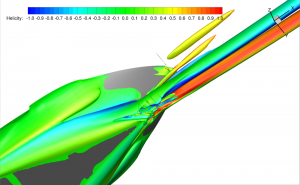
The latter proved to be particularly challenging to evaluate numerically due to its high block coefficient and the resultant complex vortex structure in the wake. Most of the participants were able to predict the global forces acting on the hull and propeller with reasonable accuracy, but only the most advanced highly-resolved LES and Reynolds Stress transport RANS models were found to be capable of capturing the nature of the hook-shaped vortex in the stern region.
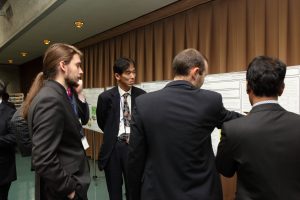
The submission by the FSI group focused on the towed and self-propelled JBC cases. The former were found to agree well with similar submissions from other institutions. FSI was the only participant to evaluate the same case using more than one code using nearly-identical numerical setup and the same grid. Doing so helped to distinguish between prediction errors due to fundamental shortcomings of the RANS method used and implementation- and user-induced inaccuracies.
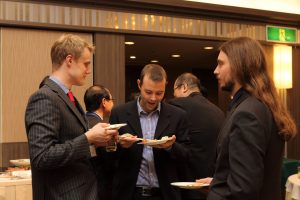
The Southampton maritime CFD team are the only UK based group to participate regularly in these workshops that originated from the International Towing Tank Conference in the 1980’s. They have presented their work in Gothenburg in 2000 and 2010 and previously in Tokyo in 2005. A number of those involved in those years attended as representatives from other organisations worldwide.
